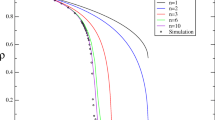Abstract
We give here a rigorous proof of the well known prediction of pair creation as it arises from the Dirac equation with an external time dependent potential. Pair creation happens with probability one if the potential changes adiabatically in time and becomes overcritical, which means that an eigenvalue curve (as a function of time) bridges the gap between the negative and positive spectral continuum. The potential can be thought of as being zero at large negative and large positive times. The rigorous treatment of this effect has been lacking since the pioneering work of Beck, Steinwedel and Süßmann [1] in 1963 and Gershtein and Zeldovich [8] in 1970.
Similar content being viewed by others
References
Beck F., Steinwedel H., Süssmann G.: Bemerkungen zum Klein’schen Paradoxon. Z. Phys 171, 189–198 (1963)
Bhabba H.J.: The Creation of Electron Pairs by Fast Charged Particles. Proc. R. Soc. London Ser. A 152, 559–586 (1935)
Brezin E., Itzykson C.: Pair Production in Vacuum by an Alternating Field. Phys. Rev. D. 2, 1191–1199 (1970)
Cowan T. et al.: Observation of correlated narrow-peak structures in positron and electron spectra from superheavy collision systems. Phys. Rev. Lett. 56, 444–447 (1986)
Dirac P.: The Principles of Quantum Mechanics. Oxford University Press, Oxford (1930)
Dolbeault, J., Esteban, M.J., Loss, M.: Relativistic hydrogenic atoms in strong magnetic fields. http://arxiv.org/list/math/0607027v1, 2006
Dürr D., Pickl P.: Flux-across-surfaces Theorem for a Dirac-particle. J. Math. Phys. 44, 423–465 (2003)
Gershtein S., Zeldovich Y.: Positron Production During the Mutual Approach of Heavy Nuclei and the Polarization of the Vacuum. Sov. Phys. JETP 30, 358–361 (1970)
Greiner W., Müller B., Rafelski J.: Quantum Electrodynamics of Strong Fields. Springer Verlag, Berlin (1985)
Hainzl C., Lewin M., Solovej J.P.: Mean-field approximation in Quantum Electrodynamics. The no-photon case. Comm. Pure Appl. Math. 60, 546–596 (2007)
Heisenberg W., Euler H.: Consequences of Dirac’s Theory of the Positron. Z. Phys. 98, 714 (1936)
Ikebe T.: Eigenfunction expansions associated with the Schrödinger operators and their application to scattering theory. Arch. Rat. Mech. Anal. 5, 1–34 (1960)
Jensen A., Kato T.: Spectral Properties of Schrödinger operators and time-decay of the wavefunctions. Duke Math. J. 46(3), 583–611 (1979)
Klaus M.: On coupling constant thresholds and related eigenvalue properties of Dirac operators. J. Reine Angew.Math. 362, 197–212 (1985)
Klein O.: Die Reflexion von Elektronen an einem Potentialsprung nach der relativistischen Dynamik von Dirac. Z. Phys. 53, 157 (1929)
Müller B.: Positron creation in superheavy quasimolecules. Ann. Rev. Nucl. Science 26, 351–383 (1976)
Müller B., Peitz H., Rafelski J., Greiner W.: Solutions of the Dirac Equation for Strong External Fields. Phys. Rev. Lett. 28, 1235–1238 (1972)
Nenciu G.: On the adiabatic limit for Dirac particles in external fields. Commun. Math. Phys. 76, 117–128 (1980)
Nenciu G.: Existence of spontaneous pair creation in the external field approximation of Q.E.D. Commun. Math. Phys. 109, 303–312 (1987)
O’Connell R.F.: Effect of the Anomalous Magnetic Moment of the Electron on Spontaneous Pair Production in a Strong Magnetic Field. Phys. Rev. Lett. 21, 397–398 (1968)
Pickl, P.: Existence of Spontaneous Pair Creation, Dissertation, 2005
Pickl P.: Generalized Eigenfunctions for Dirac Operators Near Criticality. J. Math. Phys. 48, 1 (2007)
Pickl P., Dürr D.: Adiabatic Pair Creation in Heavy Ion and Laser Fields. Eur. Phys. Lett. 81, 40001 (2008)
Popov V.S.: Positron Production in a Coulomb Field with Z > 137. Zh. Eksp. Teor. Fiz. 59, 965–84 (1970)
Prodan E.: Spontaneous transitions in quantum mechanics. J. Phys. A: Math. Gen. 32, 4877–4881 (1999)
Rafelski J., Fulcher L.P., Greiner W.: Superheavy Elements and an Upper Limit to the Electric Field Strength. Phys. Rev. Lett. 27, 958–961 (1971)
Reed M., Simon B.: Functional Analysis. Academic Press, San Diego (1980)
Rein D.: Über den Grundzustand überschwerer Atome. Z. Phys 221, 423–430 (1969)
Reinhardt J., Müller U., Müller B., Greiner W: The decay of the vacuum in the field of superheavy nuclear systems. Z. f. Physik A 303, 173–188 (1981)
Riesz F., von Sz.-Nagy B.: Functional Analysis. F. Ungar. Publ. Co., New York (1955)
Roberts C.D., Schmidt S.M., Vinnik D.V.: Quantum Effects with an X-Ray Free-Electron Laser. Phys. Rev. Lett. 89, 153901 (2002)
Rodnianski I., Schlag W.: Time decay for solutions of Schrödinger equations with rough and time dependent potentials. Invent. math. 155, 451–513 (2004)
Sauter F.: Über das Verhalten eines Elektrons im homogenen elektrischen Feld nach der relativistischen Theorie Diracs. Z. Phys. 69, 742 (1931)
Scharf G., Seipp H.P.: Charged Vacuum, Spontaneous Positron Production and all that. Phys. Lett. 108B, 196–198 (1982)
Schweppe J. et al.: Observation of a Peak Structure in Positron Spectra from U+Cm Collisions. Phys. Rev. Lett. 51, 2261–2264 (1983)
Schwinger J.: On Gauge Invariance and Vacuum Polarization. Phys. Rev. 82, 664–679 (1951)
Smith K., Peitz H., Müller B., Greiner W.: Induced Decay of the Neutral Vaccum in Overcritical Fields Occurring in Heavy-Ion Collisions. Phys. Rev. Lett. 32, 554–556 (1974)
Teufel S.: Adiabatic Perturbation Theory in Quantum Dynamics. Springer Verlag, Berlin (2003)
Teufel, S.: The flux-across-surfaces theorem and its implications for scattering theory. Dissertiation an der Ludwig-Maximilians-Universität, München, 1999
Thaller B.: The Dirac equation. Springer Verlag, Berlin (1992)
Yamada O.: Eigenfunction expansions and scattering theory for Dirac operators. Publ. RIMS. Kyoto Univ. 11, 651–689 (1976)
Zeldovich Ya.B., Popov V.S.: Electronic Structure of Superheavy Atoms. Sov. Phys. Usp. 14(6), 673–694 (1972)
Author information
Authors and Affiliations
Corresponding author
Additional information
Communicated by H. Spohn
Rights and permissions
About this article
Cite this article
Pickl, P., Dürr, D. On Adiabatic Pair Creation. Commun. Math. Phys. 282, 161–198 (2008). https://doi.org/10.1007/s00220-008-0530-5
Received:
Accepted:
Published:
Issue Date:
DOI: https://doi.org/10.1007/s00220-008-0530-5



